CHJ
Established Member
Rotating objects and the use of woven materials.
Anyone who has been fortunate enough to pass through an engineering training environment should have had it ingrained into their awareness that the use of woven fabric cloths around rotating machine parts is highly dangerous and any cleaning requiring the use of cloths must be done with the machine switched off, isolated from power and all parts stationary.
This is because of the risk of the cloth catching in the moving parts and dragging fingers, hands, arms and in worst case body into the machine.
Now you might say; “what has this to do with me in my little home workshop?”
Well the subject came up recently on the UKWorkshop forum (https://www.ukworkshop.co.uk/forums/viewtopic.php?t=20014) and although many of us are aware of the problems it occurred to me that it is a subject rarely discussed outside ‘spinney things’ and a newcomer may not be aware of the risks.
It is not unknown for someone using a sewing machine to pass their fingers under the needle wrapped in the cloth they are seaming. (in fact it is an old adage that until you have done it you’re not a machinist)
Likewise even someone using a small pen lathe in a back bedroom is working with a machine capable of removing a finger.
(something far more significant than removing a needle with a pair of pliers, been there done that, the needle bit that is, lets not go there!).
To this end all instructors in a wood turning environment will, or may I be so bold to say should, advocate the use of non woven frangible material when applying coatings and smoothing or buffing a piece on the lathe whilst it is rotating.
This material is known generically as Safety Cloth, it may be made from paper or cotton fibres and is designed to tear rather than drag your hand into the work if it catches.
This is sound advice and if you were to live in an ideal world one that would never be ignored.
However, everyone who has turned a piece of wood knows that just as you need a piece you have run out, add to this fact that it is not a low cost item for something that is rapidly destined for the waste bin and the inevitable reach for a kitchen roll ensues.
Nothing wrong with this it’s frangible and for some things such as applying a sealer this is fine, but try buffing or burnishing with it and the inevitable happens, the material tears and sticks to the piece, in fact it is not unknown for even improved texture safety cloth to do likewise with frustrating results.
So the temptation arises to use a piece of woven fabric such as an old handkerchief, tea towel, bed sheet etc. and once tried it is found to do the job and in some instances be more effective at achieving the desired result.
So do you continue to use it or heed all the warnings and never do it again!
Well we all live in the real world and like crossing the road the risks can be reduced considerably if you take the appropriate precautions.
The very same precautions I might add that should be applied to the use of strips of abrasive material which are often designed to be anything but frangible.
1. Always remove all tool rests and anything that could trap your hand between the turned piece and the lathe bed even when using frangible cloth.
2. Never wrap the material around the fingers or hand to get a better grip.
3. Always hold it with the tips of the fingers or thumb and resting on the palm of your hand so that it can be snatched easily from your grip if it catches.
4. Always approach the work piece from the nine o’clock to six o’clock position looking at the face of the chuck so that your hand will be pulled down and clear should anything catch.
5. If working on a Bowl, ball the cloth up so that any loose edges are contained within the ball and hold in the finger tips.
A couple of things to try if you do not already use them, apply your sealer or preferred finish with a soft brush instead of a ‘cloth’, I keep my brush in the sealed bottle to prevent it hardening and ‘wring it out’ on the inner surface before use.
Burnish a finish with a burnishing bristle mop or a semi stiff brush such as a bristle clothing or shoe brush rather than a cloth of any sort, this is especially useful for irregular shaped pieces which by their very nature are designed to modify the fingers or hands. But remember when burnishing this way the above rules should still be applied.
This is Safety Cloth in use, note torn edges.
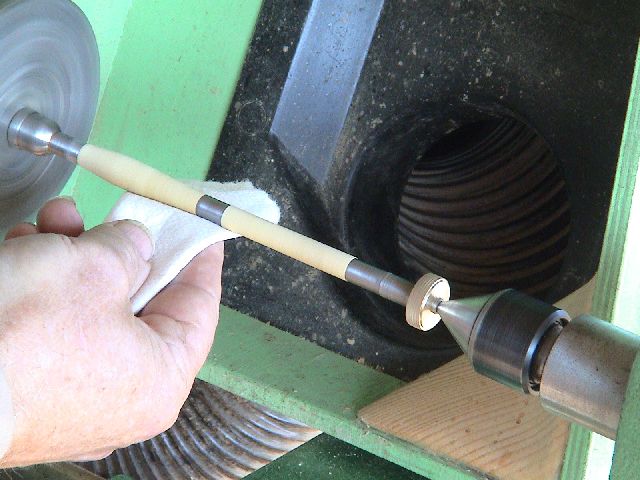
Various images showing a reasonably safe way to hold abrasive and woven fabric.
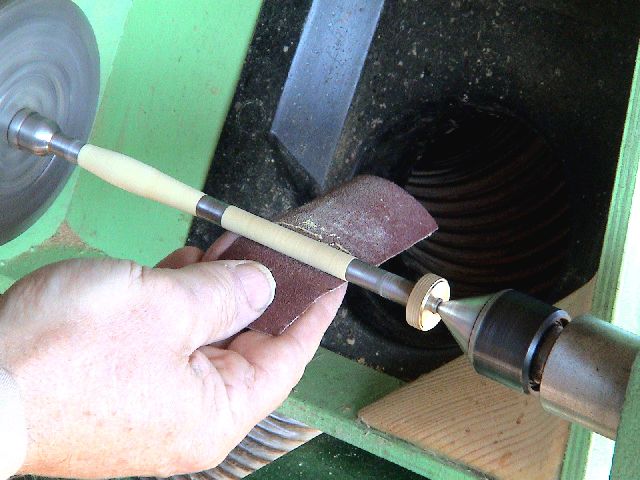
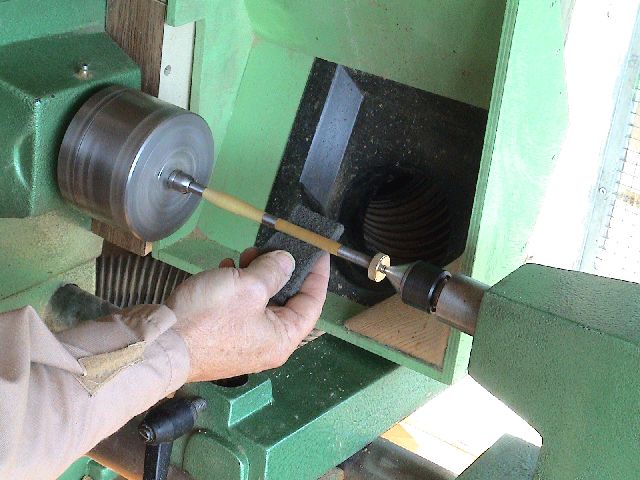
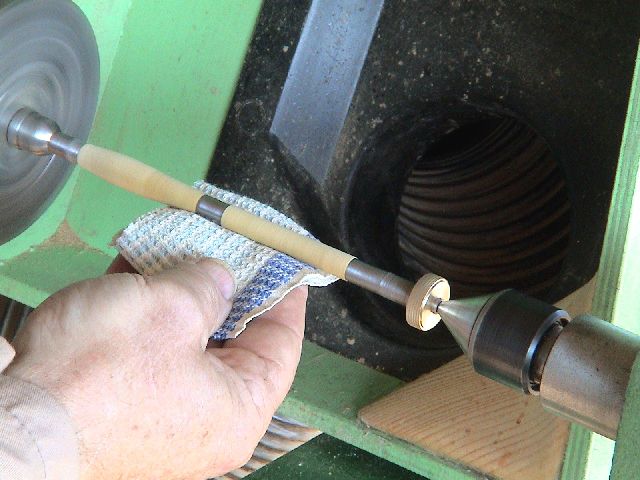
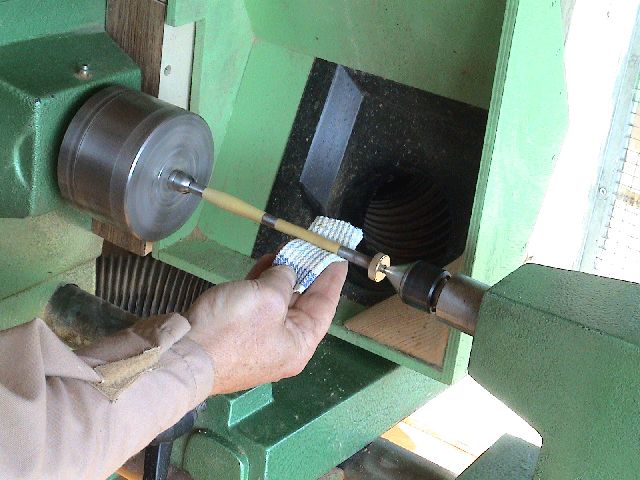
Never wrap a piece of cloth around the fingers like this, even if it is Safety Cloth the multiple thicknesses may be too strong to give way before a hand is grabbed.
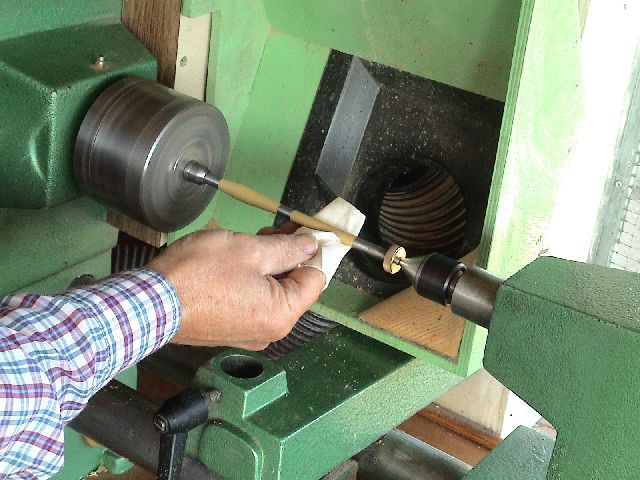
A balled up piece of cloth being used to burnish a bowl.
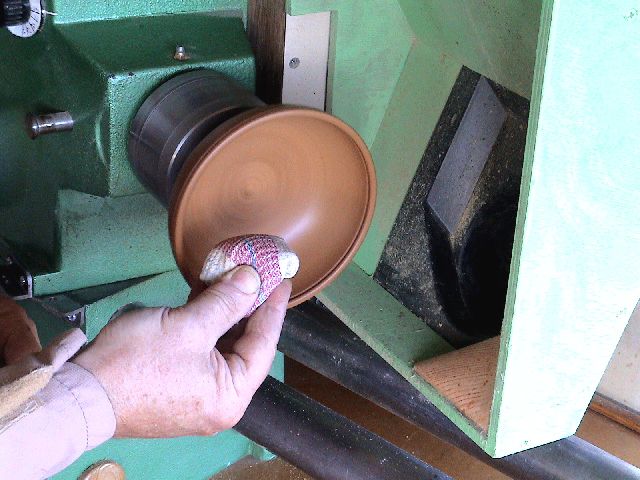
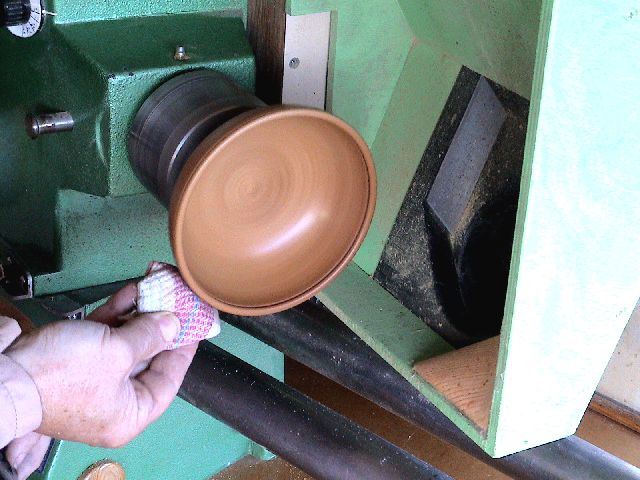
Applying sealer with a brush and how I store it.
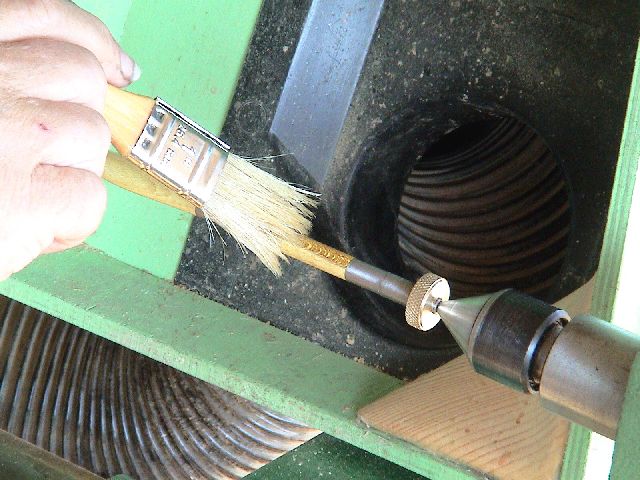
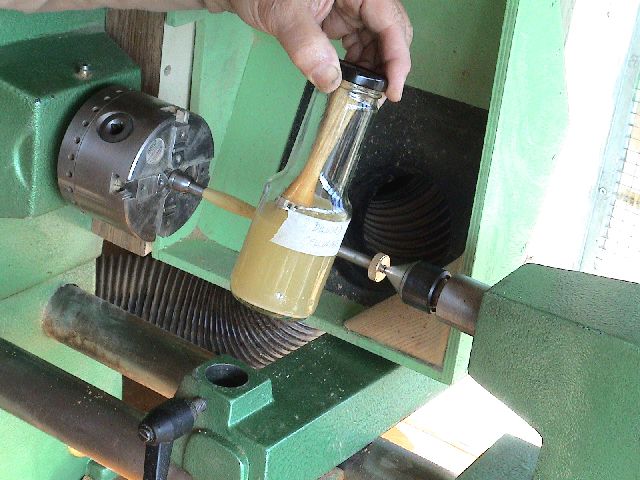
23rd Oct.2007
Anyone who has been fortunate enough to pass through an engineering training environment should have had it ingrained into their awareness that the use of woven fabric cloths around rotating machine parts is highly dangerous and any cleaning requiring the use of cloths must be done with the machine switched off, isolated from power and all parts stationary.
This is because of the risk of the cloth catching in the moving parts and dragging fingers, hands, arms and in worst case body into the machine.
Now you might say; “what has this to do with me in my little home workshop?”
Well the subject came up recently on the UKWorkshop forum (https://www.ukworkshop.co.uk/forums/viewtopic.php?t=20014) and although many of us are aware of the problems it occurred to me that it is a subject rarely discussed outside ‘spinney things’ and a newcomer may not be aware of the risks.
It is not unknown for someone using a sewing machine to pass their fingers under the needle wrapped in the cloth they are seaming. (in fact it is an old adage that until you have done it you’re not a machinist)
Likewise even someone using a small pen lathe in a back bedroom is working with a machine capable of removing a finger.
(something far more significant than removing a needle with a pair of pliers, been there done that, the needle bit that is, lets not go there!).
To this end all instructors in a wood turning environment will, or may I be so bold to say should, advocate the use of non woven frangible material when applying coatings and smoothing or buffing a piece on the lathe whilst it is rotating.
This material is known generically as Safety Cloth, it may be made from paper or cotton fibres and is designed to tear rather than drag your hand into the work if it catches.
This is sound advice and if you were to live in an ideal world one that would never be ignored.
However, everyone who has turned a piece of wood knows that just as you need a piece you have run out, add to this fact that it is not a low cost item for something that is rapidly destined for the waste bin and the inevitable reach for a kitchen roll ensues.
Nothing wrong with this it’s frangible and for some things such as applying a sealer this is fine, but try buffing or burnishing with it and the inevitable happens, the material tears and sticks to the piece, in fact it is not unknown for even improved texture safety cloth to do likewise with frustrating results.
So the temptation arises to use a piece of woven fabric such as an old handkerchief, tea towel, bed sheet etc. and once tried it is found to do the job and in some instances be more effective at achieving the desired result.
So do you continue to use it or heed all the warnings and never do it again!
Well we all live in the real world and like crossing the road the risks can be reduced considerably if you take the appropriate precautions.
The very same precautions I might add that should be applied to the use of strips of abrasive material which are often designed to be anything but frangible.
1. Always remove all tool rests and anything that could trap your hand between the turned piece and the lathe bed even when using frangible cloth.
2. Never wrap the material around the fingers or hand to get a better grip.
3. Always hold it with the tips of the fingers or thumb and resting on the palm of your hand so that it can be snatched easily from your grip if it catches.
4. Always approach the work piece from the nine o’clock to six o’clock position looking at the face of the chuck so that your hand will be pulled down and clear should anything catch.
5. If working on a Bowl, ball the cloth up so that any loose edges are contained within the ball and hold in the finger tips.
A couple of things to try if you do not already use them, apply your sealer or preferred finish with a soft brush instead of a ‘cloth’, I keep my brush in the sealed bottle to prevent it hardening and ‘wring it out’ on the inner surface before use.
Burnish a finish with a burnishing bristle mop or a semi stiff brush such as a bristle clothing or shoe brush rather than a cloth of any sort, this is especially useful for irregular shaped pieces which by their very nature are designed to modify the fingers or hands. But remember when burnishing this way the above rules should still be applied.
This is Safety Cloth in use, note torn edges.

Various images showing a reasonably safe way to hold abrasive and woven fabric.




Never wrap a piece of cloth around the fingers like this, even if it is Safety Cloth the multiple thicknesses may be too strong to give way before a hand is grabbed.

A balled up piece of cloth being used to burnish a bowl.


Applying sealer with a brush and how I store it.


23rd Oct.2007

































